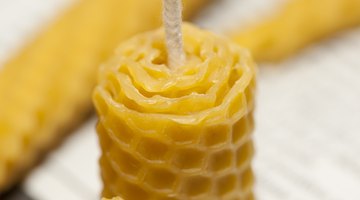How Do Dripless Candles Work?
Not all candle waxes are created equally. A "dripless" candle creates the least amount of dripping, molten wax when lit, while a "drip" candle anchors the opposite end of the spectrum, dripping as much as safely possible for an intentional wax buildup over a bottle or candleholder.

The secret to each type of candle is the wax blend; the harder the outer layer of wax, the less likely it is to drip.
Paraffin Wax Properties
Paraffin is one of the most common types of wax used for candles; unless the packaging states otherwise, a store-bought candle is most likely made of paraffin. The paraffin used from one type of candle to the next varies greatly, however. Pillar and taper candles require a fairly hard wax -- at least on the outside; otherwise, the candle melts into a puddle, creating quite the mess. Candles designed to be used inside of a container, such as jar candles, votives and tea lights, are made from a softer version of paraffin that eventually melts down to almost nothing. A "dripless" candle, depending on its shape and width, is an ideal blend of hard wax and a perfectly sized wick. Some versions may contain additives such as stearic acid or a softer wax in the center column of the candle. Stearic acid is also used in soap-making to make a harder soap bar.
Beeswax Benefits
Beeswax serves as an alternative to paraffin candles, and candles made from pure beeswax are naturally dripless. Besides the basically drip-free illumination, beeswax candles emit a honey scent while burning. Beeswax candles also do not emit smoke, resulting in a clean, non-toxic burn. These candles are also said to clean the air by releasing negatively-charged ions.
Wick Factors
The candle's wick also plays a factor into the amount of wax that drips as the candle burns. If the wick is too small for the candle or exceedingly large, it could cause the candle to drip. If the wick isn't properly trimmed, it could also cause dripping, even on a dripless candle. The wick should be trimmed to 1/4-inch before lighting, if it hasn't already been trimmed by the manufacturer.
Other Considerations
For a dripless candle to remain dripless, burning conditions must be ideal. The candle has to stand up vertically -- not even at a slight angle -- to keep the drips at bay. Keep the dripless candle away from drafts as well, as a slight breeze could cause the flame to flare up larger than usual or to touch areas of wax that it normally wouldn't reach, causing drips.
References
Resources
Writer Bio
Kathy Adams is an award-winning journalist and freelance writer who traveled the world handling numerous duties for music artists. She writes travel and budgeting tips and destination guides for USA Today, Travelocity and ForRent, among others. She enjoys exploring foreign locales and hiking off the beaten path stateside, snapping pics of wildlife and nature instead of selfies.
Photo Credits
- Darko Jagodic/iStock/Getty Images
- Darko Jagodic/iStock/Getty Images
More Articles



